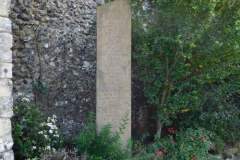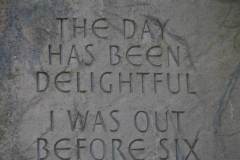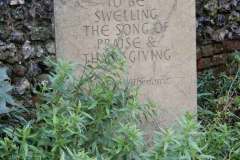This stone is located in the Memorial Garden. The words are attributable to William Wilberforce (1759-1833) the, politician, philanthropist and devout Christian who tirelessly campaigned for the abolition of the British slave trade. The quotation reads:
The day has been delightful.
I was out before six & made the fields my oratory the sun shining as bright & as warm as at midsummer.
I think my own devotions become more fervent when offered in this way amidst the general chorus with which all nature seems on such a morning to be swelling the song of praise & thanksgiving.
Wilberforce wrote these words in 1786 in a letter to his sister when describing Easter Sunday.
The sculpture is by Richard Kindersley and is entitled Art and Memory. Kindersley learned much of his craft in the workshop of his father, David, who some 35 years before had carved the wall tablet to Alfred Deller in the South Choir Aisle (insert link). Richard continued to study typeface and sculpture at Cambridge School of Art before he set up his own London studio in 1970.
Art and Memory is carved from a single slab of Caithness Stone. This slab is a siltstone from the Old Red Sandstone of Devonian age (c.370 million years ago). The Caithness sediments of north-east Scotland are a mixture of finely-bedded clays, siltstones, sandstones and limestones deposited in a large body of freshwater known as Lake Orcadie. The sandstones and siltstones are used for flooring and roofing tiles when they are marketed as Caithness Flagstone. The stones have also been popular for fine sculptural work. The sculpture is in the form of a standing stone, reminiscent of the Neolithic monument, The Standing Stones of Stenness in Orkney, which are carved from very large slabs of the local Caithness Stone.
Click below to enlarge the images and read the captions
Geoff Downer 2019



